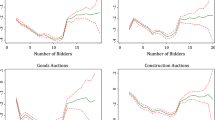Abstract.
In this paper, we characterize an optimal procurement policy as a mechanism design problem when an allotment of the contract is available, i.e., when a government faces both SMEs and large firms for carrying out a heterogeneously divisible project. Our model allows us to analyze all procurement policies (set-asides, favoritism, non-discriminatory rules), taking into account both efficiency and distributive arguments and derive a normative framework. We show that set-asides are not generally optimal, whatever the industrial preferences of the government are, while the optimal preferential treatments of firms implies complex non-linear rules. We prove that the optimal policy can be implemented using a modified Vickrey-type auction. We also consider that the firms can reduce their cost by a non observable effort, and exhibit the specific impact of cost reduction incentives on the optimal policies.
Similar content being viewed by others
Author information
Authors and Affiliations
Corresponding author
Additional information
Received: 24 September 2001,
JEL Classification:
D44
Pierre-HenriMorand : I am grateful to the anonymous referees for comments. The usualdisclaimer applies.
Rights and permissions
About this article
Cite this article
Morand, PH. SMEs and public procurement policy. Review Economic Design 8, 301–318 (2003). https://doi.org/10.1007/s10058-003-0104-0
Issue Date:
DOI: https://doi.org/10.1007/s10058-003-0104-0




